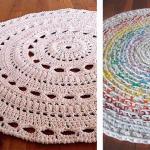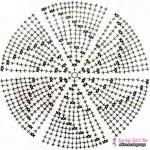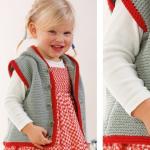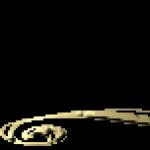Mesh skirt with ribbon. Fashionable tutu skirt - a “children’s” trend or an adult woman’s choice
A tutu skirt is usually associated with lightness and airiness; young ladies and teenagers love to wear it. However, if you follow fashion trends, you have probably noticed “adult” stars dressed in tulle skirts that do not look vulgar on them. Of course, stylists work on the images of celebrities, but mere mortals can put together a stylish look after learning a few simple rules what to wear with a tutu skirt Everyday life.

Tutu skirts can be different styles- lush, “ballet-like”, simply airy in the shape of a bell, they can be long or not very long. Are there any restrictions on wearing a tutu, or is it Any will do girl? We will try to highlight this in this article.
Below you will read:
What is the secret of the polarity of a full skirt for girls?
As you might guess, the prototype of the tutu skirt was taken from ballet costumes - you can see light, airy and fluffy skirts in any of the classical productions. English-speaking countries playfully call it “tutu”. Like any wardrobe item that has gained popularity, this skirt can be found in different variations - both in stylish, festive ones, and in infantile or even sloppily assembled looks brought to the point of grotesque and absurdity.
The distinctly doll-like style does not suit everyone, and is more often used for photo shoots, cosplays, and so on. In ordinary life, almost no one wears lush and short tutus - fortunately. This is where some girls dislike this skirt - they say it looks stupid and childish. Today we will debunk the myths and prejudices around this wonderful thing.


What types of tutu skirts can there be? The most famous are short and knee-length, rather fluffy and translucent semi-rigid tulle skirts. You can often find a medium-length tutu skirt with flounces or ruffles. Long, half-puffy tutus look great - they have a worthy place in every girl’s wardrobe. It can be either single-color or bright, translucent or dense.



How to choose the right tutu skirt style?
So, let's figure out who tutu skirts are suitable for. Let’s tell you a secret right away – everyone can wear them, you just need to choose the right style and color. If you start from the styles, the pack can be matched with everything, with the possible exception of sportswear. Of course, a tutu skirt fits perfectly into a naive style - caramel, light, pastel tutu skirts of medium and short length will look organic and appropriate.


Fans of a dramatic style, on the contrary, will appreciate long translucent tutus with many ruffles, red or black; lovers of the classics will like a medium-length tutu in neutral shades, either black or gray.


A tutu of “interesting” colors – deep purple, burgundy – goes well with a romantic style. The style in this case can be anything, because few people experiment with complex colors. The final style is natural. Everything is simple here - any length, medium volume, neutral, woody shades.

How to choose a tutu skirt taking into account your height and body type
How to choose a tutu according to your body type? For slender girls and girls with slightly plump hips, fluffy knee-length tutus are well suited; they will visually even out the proportions and turn the silhouette into a “girlish” one. Curvy fashionistas usually avoid tutus for fear of looking bigger, and they do it in vain - flowy long skirt looks great on them.

With selection by height, everything is easier. A tutu skirt goes well with heels - especially midi and maxi options, but do not wear a floor-length skirt - it looks inappropriate in everyday life. A short and fluffy tutu will look comical on a tall girl. For girls of average height, medium length suits them best. For tall girls, knee-length and slightly lower options are suitable.


How to choose a tutu skirt for an adult girl?
There is an opinion that a tutu skirt is for teenagers, and if you are older than 20-23, you should not choose such an infantile outfit. This opinion is erroneous, and is based on the bows mentioned above - grotesque, emphatically childish. A tutu skirt that fits into your wardrobe and has the right color and style will always be appropriate and attractive, regardless of your age. The only caveat is that if you are not a fan of naive, try to avoid too short and lush packs of flashy colors.








How to look stylish if you are plus size?
How to choose a skirt plump girl? If yours is proportional, you can safely take any style of tutu skirt of medium fullness, just watch the length - the optimal length is knee-length or slightly lower. A more difficult selection for an apple-type figure - with an undefined waist. Thanks to the tutu, you can create this waist. In order for the image to look harmonious, you will have to choose a more or less adjacent top, also average length skirts, but – attention – choose a model that has a wide belt and good fluffiness. Visually, your figure will look more harmonious - the fullness of the skirt will create the right silhouette, adding to the difference in volume between the waist and hips.



What to wear with a tutu skirt in autumn and winter?
What shoes and accessories to wear with a tutu skirt, especially in the cool season? Most often it is recommended to wear a pack. By themselves, tights are a rather capricious accessory, but in combination with a tutu, it is completely difficult to maintain balance and not slip into vulgarity. Moreover, Russian realities, with their cold winters and variable off-season, will not allow you to walk lightly.

To create a harmonious look, remember that a tutu skirt looks good with tights and knee socks, the main thing is not to overdo it - frankly “knitted” models of tights go very poorly with light translucent fabric. Almost any shoes with a closed toe and a round or triangular toe, or not too massive ankle boots, neat low shoes, are suitable for footwear. Fans of extreme style can try wearing it with a skirt or - this combination looks modern and playful.

In spring and summer, a tutu skirt is appropriate to wear with pumps or sandals that match the style, this look looks harmonious and elegant.



As an example, let’s take this season’s trendy 4-tier chiffon tutu skirt. Choose the color of the fabric at your discretion, but pastel colors are preferred: beige, white and black. So, here's what we need in order to sew a tutu skirt: 1.5 meters of chiffon, ruffles (optional), thread, scissors and some free time.
The first step is to sew the yoke of the tutu skirt. This will require half a meter of chiffon. The fabric needs to be folded in half and ironed. The first (out of 4) tier, 10 cm long, will be sewn to one of the sections. The chiffon tiers must be gathered and sewn on top of each other. We cut the required number of chiffon strips, namely four, then sew them together in short sections in tiers, and then gather them together. It should look like this: the first tier is sewn to the yoke, the second tier is sewn to the first, the third tier is sewn to the second, and the fourth to the third. The base of the tutu skirt is ready.
Next we attach the ruffles. Finish the stripes with an overlock stitch, gather and sew the required amount on the front side of the skirt. The larger the ruffle, the more voluminous the tutu skirt will be. Next, you need to process the seams and sew the yoke approximately 3 centimeters from the fold. But at the same time, make sure that there is room for the elastic. If desired, you can decorate the tutu skirt with a ribbon.
Now you know how to sew a tutu skirt with your own hands, all you have to do is find out what to wear with a tutu skirt.
1.
2.

|
Do you think it’s difficult to sew a dress with a full skirt? Not at all! If you're just a beginner seamstress, here are some options for you. evening dresses with a full skirt. I suggest you sew the top from beautiful and high-quality knitwear - it is very easy to work with and can allow you to tightly fit the body and highlight thin waist, and the bottom is a tutu or American skirt. The length of the skirt can be completely different. I personally like the uneven length of the skirt - shorter in the front, longer in the back, reaching to the floor. It looks very impressive. The fullness of the skirt can also be completely different. For prom, you can only sew a skirt, for example, a black one, and buy or sew (if experience and skill allow) a corset for it. Corsets for a black skirt can be chosen in any color. Here are your options
These are American girls. You can sew such a miracle from mesh suitable color And And the scheme is like this
And here is the tutu skirt
more pancake option
Less lush
Uneven |
This ballet skirt has long stepped from the stage into the wardrobes of thousands of women. The tutu skirt, or rather its more suitable variety for everyday wear - the tunik, also known as the tutu, is a favorite of fans of the TV series Sex and the City.
The main character Carrie Bradshaw wore such skirts with T-shirts, T-shirts, and jeans, successfully diluting some of the pathos of the shoppenka with simple everyday things. And search engines still accurately return examples of chopins for the query “skirt like Carrie’s.” The heroine of the series was dressed by the world's best stylists, but you can make such a skirt yourself. We offer three ways to sew a shopinka with your own hands!
Method one: almost no sewing
Necessary:
- fabric for lining - satin will do, but you can experiment,
- elastic band for the belt.
1. This skirt is made without sewing, very quickly. We decide on the length of the elastic band that will hold the tutu skirt. It is important that it can be easily removed through the hips. Sew the edges of the elastic.
2. Determine the length of the skirt. We cut tulle ribbons 5-10 centimeters wide and twice as long as the desired length. We bend the finished ribbons in half and tie them with an elastic band. We do this until we completely cover the elastic with fabric.
3 . The tutu skirt is ready! It is also worth taking care of an opaque petticoat or wearing this skirt with tight tights or leggings! Manufacturing details can be seen in this video:
Method two: simple, but fattening
Necessary:
- the main fabric for the skirt is tulle,
- fabric for lining - satin will do, but you can experiment.
- Elastic band for the belt.
A very simple way is to cut out a “sun” skirt. Since tulle is often sold in rolls 2-3 meters wide, this will not be difficult. To create a pattern you need only two measurements: waist circumference and skirt length. We fold the fabric 4 times, to create a pattern we use the diagram:
1. We decide how many layers there will be in the skirt - so many “suns” and cut it. Since this type of cut is more suitable for fragile girls, and even people of average build are a little plump, it is better not to do more than three layers.
2. We prepare the lining: we cut it according to the width of our hips, along the length - 5 centimeters shorter than the chosen length of the skirt.
3 . Then there are two ways. First, we collect all the tulle skirts into one and fasten them with a belt to an elastic band sewn into a ring around the waist (it is important to check that the elastic stretches easily over the hips). We sew the finished design onto the lining skirt. We grind the edges of the lining (tulle does not need this). The skirt is ready!
4. By the way, tulle skirts can be made different lengths- sew the longest one closer to the lining, the shortest one outward. The result is a skirt that resembles a three-tier cake.
Method three: suits any figure, but you have to work hard!
1. This method is somewhat more complicated. Tulle is not cut by the sun, but cut into strips. The first is the width of the expected length of the skirt, the length is two hip circumferences. The second one is 5 centimeters narrower than the first one, and the same length. The third is 5 centimeters narrower than the second, the same length.
2. Just like in the first and second cases, we sew a lining skirt, but there are two different options.
3. You can make a skirt that gathers at the waist with an elastic band - then it’s easier to make the petticoat regular, rectangular.
You can make a skirt that fastens with hooks - in this case it is better to cut the petticoat in the form of an a-line or straight - but take care of the darts so that the skirt sits well on the waist and hips. Then she won't fill up.
4. At the back or side we make an incision 5-10 centimeters deep, and depending on the curvature of your spine, we cut it to the point where the skirt can be removed “through the legs”. We grind the edges and sew on the hooks.
5. Now comes the hard part. We take strips of tulle, and, armed with a needle and thread, we begin to “gather” them, so as to bring their width to the approximate girth of our petticoat. You can watch how to squash in this video:
6. The sewing method from this video can also be adopted, but we do it a little differently. We plan that we will sew the first tulle skirt onto the petticoat closer to the waist, the second - 5 centimeters lower, the third - the same amount lower.
7 . After this, we connect the edges of the assembled tulle skirts and sew them together, leaving 5-10 centimeters free at the top for the very top skirt.
8. Now the finished tulle skirts need to be sewn to the petticoat - no longer by hand, but using a machine.
9 . Then we remove the threads that were used to gather the fabric.
10 . All that remains is to design the belt - you can sew a grosgrain ribbon to the finished skirt, which will be tied at the back. Or sew two ribbons together to make a rigid belt, and attach loops and hooks to the edges. We attach it to the finished skirt. It should look something like this:

And now - some inspiring ideas on how to wear a tutu skirt and a chopin skirt:
Do you like these skirts?
Photos found on pinterest.com
Airy, marshmallowy, weightless, elegant - when you wear it, you feel a real lady! It is almost universal - in spring and summer, autumn and winter, for visiting and on a date... There are many questions: what to combine with? Which style suits me? How to sew a tulle skirt with your own hands? Now let's take a closer look at the last question.
Materials
The first question that naturally arises for a novice dressmaker is: how to calculate the amount of material?

Amount of tulle
It is difficult to give an absolutely exact figure, since material consumption depends on several factors.

The first factor is density. For hard tulle, the consumption will be the least, but a model made of such material will stick out very much. You will need many times more soft (to achieve the desired pomp, you will have to resort to multi-layering).






The best option- four layers of tulle of medium hardness and one layer of soft tulle (for the overskirt).

The second factor is style.

Quantity of lining material
If the tulle is dense and there are quite a lot of layers, you can do without a cover (petticoat). If it is transparent, then you need to think about satin, viscose or some other lining fabric.

To understand whether you can fit into one width, you need to multiply your waist circumference by 1.5.

Reference! The number 1.5 means the assembly coefficient, in other words, its density - the higher the coefficient, the thicker the assembly.

This calculation will help determine the width of the underskirt (lining). If the number does not exceed 140, it means that one width is enough for you (the width of fabrics in stores rarely exceeds 140 cm). Feel free to buy a cut equal to the desired length of the petticoat.






If the value (waist circumference multiplied by 1.5) is greater than 140, two solutions are possible:
- It will be limited to a more modest density of gathering on the petticoat, allowing it to serve only as a cover.
- Buy a piece of fabric equal to the length of the petticoat multiplied by 2 plus 5 cm.

Basic fittings
Threads in the color of the fabric. Elastic band in the color of the main fabric - usually 5 cm wide. The length of the elastic band is equal to the waist circumference.

Rectangle skirt
Fabric calculation. A rectangular skirt is the most economical option. In this style, only two parameters appear: the desired number of layers and the expected density of each layer.

The following options are possible:
- Double layer. Both layers are six meters wide. Length is optional.
- Three-layer. Each layer is three meters wide. Length is optional.
- Three-layer. The first and second layers are six meters each, the bottom one is three meters. Length is optional.
- Three-layer. The top one is nine meters, the middle one is six meters, the bottom one is three meters. Length is optional.
- Four-layer. All layers are three meters wide. Length is optional.






In accordance with the chosen style, calculations can be made.

Important! First, it is better to decide on the choice of tulle, since the width of the fabric varies greatly among different manufacturers - from 1.50 cm to 3 m.

Sewing
Cut the required number of rectangles with a height equal to the length of the product. Prepare the layers by stitching the rectangles together along vertical cuts. For details of tulle processing, see below, in the “Processing Secrets” section.

Gather each layer separately along the top cut.

Important! Since the product is made without a zipper, during the gathering stage, make sure that the gathered top passes through the hips! Finally, it will be secured with an elastic waistband.

Sew the elastic with a 1 cm seam. Divide the top of the skirt into 4-8 equal sections using pins with colored heads. Divide the bottom of the elastic into 4-8 sections using pins with colored heads.






Important! The shorter the sections, the more uniformly and efficiently the pairing will be completed.

Pin the top of the skirt with the elastic bottom. The elastic is applied to the upper section of the skirt; The previously separated areas on the skirt and elastic are combined. At the same time, the elastic band is slightly stretched. For this procedure, you will need the back of a chair (pull) or the help of another person (hold while you pull and pin the section of the belt).

Adjust the elastic to the skirt.

Shopenka skirt
The same “sun” skirt made of several layers. Each layer is a circle with a hole in the waist area. The radius of the waist circumference is calculated using the formula.

For a regular circle skirt without gathering at the waist (with a belt and zipper), this formula is: waist circumference multiplied by 0.32. A circle is drawn, and the length is evenly laid down from the waist line.









If you make a circle skirt from tulle without gathering, the layers will simply fold into one another and there is a risk of getting regular model moderate volume.

To prevent this from happening:
Firstly, it needs gathering at the waist. The formula for calculating the small radius (radius of the waist circumference) will change slightly. If you are planning a model not with a zipper, but with an elastic band, you should take as a basis not From (waist circumference), but About (hip circumference). The hip circumference is first multiplied by the coefficient (thickness) of the fit - at least 1.5. We multiply the resulting result by 0.32.









Secondly, it is better to alternate layers. “Sun” - rectangle - “sun” - rectangle.

In order not to make mistakes in the calculations, it is better for a beginning craftswoman to do paper pattern two panels of a “sun” skirt. It's a little troublesome, but it's clear. Then, keeping in mind the width of the fabric from which the product will be sewn and the existing patterns, you can lay out the patterns on the floor and simply measure how much fabric is needed for one layer.

Tutu skirt
The principle of execution is the same as that of the previous model, with the difference that the pack contains much more layers. Model for very slim girls.

Other models
You can sew other models of tulle skirts with your own hands:
- "American"
- "Tutu"
- Longline
- With a train






Processing secrets
Tulle is sewn with a zig-zag seam: stitch length 2 mm, width 1.5. There is no need to process the bottom - it does not crumble.

Each panel is assembled separately. Departing 0.7 cm from the top cut, machine stitching is done, setting the largest stitch pitch. Then lay a second line - 1 cm below the first. Leave long ends of the threads, which are carefully pulled together.

Children's
A tulle skirt for an older girl will be practically no different from the option for a girl.

For a photo shoot of a newborn baby, you can “sew” an original and simple version of a tutu skirt. “Sewing” is a strong word, because in fact this skirt does not need to be sewn!

Cut many strips (40-60 pieces) 5-15 centimeters wide. They can be multi-colored or plain. The length of the stripes is equal to the length of the skirt multiplied by 2. Sew the elastic band around - by hand or on a machine.

Fold each strip in half. Tie with an elastic band double knot or a “loop” knot (in this case it will not be very fluffy).






Important! You need to tie it not too loosely, but also not to overtighten the elastic. To speed up the operation, you can cut out a piece of thick cardboard and place it under the strip each time you tie a knot. It will help regulate uniform tension.

Pull the strips tightly together so that the elastic is not visible between the tulle strips.

Get inspired, create, dress in airy tulle clouds and feel like queens! Photos of variations of tulle skirts will help you imagine yourself in the image!

Photo of a do-it-yourself tulle skirt














Elastic mesh (nylon with the addition of polyester) material with hollow cells of various sizes is used for sewing petticoats, as well as improvised multi-layer skirts of various volumes.
In the 19th and 20th centuries, petticoats, worn on a dense frame (“crinolines”), were sewn from stiff cotton fabric, which included horsehair. Modern products this kind sewn from tulle.
ads-chery.ru
Features of working with a grid
- Before cutting, the fabric must be ironed to allow it to shrink.
- It is not necessary to process the edges of the mesh - it is not subject to shedding.
- When working on sewing machine use a thin knitting needle.
Before you start sewing a skirt made of mesh fabric, you should decide on the style of the product:
- case for mini base;
- or volumetric model “sun”;
- or a three-dimensional “pack” model.
Volumetric mesh models are attached to an elastic band, which can be decorated with a belt. Creating tulle products takes a small amount of time.
Case for mini model
A transparent single-layer product is worn over a miniskirt or the base is put on a cover. The color of the mesh is selected in accordance with the color of the finished waist product. Short shorts can be used instead of skirts.
Progress
- Place the product on top of the mesh fabric.
- Wrap the mesh around the product, aligning its side seam with the mesh edges. Take into account the necessary allowances.
- Raise the fabric 15 cm above the belt of the finished model.
- From the bottom edge of the product, measure the required amount of mesh material.
- Process the bottom of the cover
- Cover the finished product.
Fold the 15 cm margin at the top and sew it to the base using a machine stitch.

turboimg.net
Volumetric model of the “sun” type
The item consists of a certain number of semicircular parts (wedges) of the skirt and two lining parts.
Progress
- Fold the mesh piece into quarters.
- Determine the length of the product.
- Mark the waist level by drawing a radius in the upper left corner (equal to the waist circumference value divided by 6).
- Cut out the appropriate piece of multilayer mesh, taking into account the allowance (about 2 cm).
- Prepare the remaining fragments in the same way (the number of parts is limited by the degree of “splendor” of the future product).
- The lining is made on the basis of the A-line skirt pattern and is tightened according to the waist circumference using two parallel lines, the parameters of the lining part are calculated according to the hip volume measurement (the length of the lining will correspond to the length of the item minus 5 cm).
- Sew the lining piece to the product using a finishing stitch.
- Connect an elastic band into a ring (its width should be 1 cm less than the waist circumference).
- Divide the rubber ring into 4 parts - these are control marks (according to them, sew the multi-layer skirt to the elastic belt).
- Turn the product right side out.

tildacdn.com
Volumetric model of the “pack” type
A product of one, two or three colors is made from a certain number of strips of fabric, folded in half. For convenience, it is recommended to use mesh in small rolls rather than purchasing fabric by the meter.
The length of each mesh strip should be equal to the measurement of the length of the product, multiplied by two. The width of all fragments is the same - from 15 to 20 cm. With an increase in the number of blank strips, the degree of splendor of the “pack” will increase. The average number of stripes exceeds 100.
- Prepare mesh sections using a cardboard layout - a strip with a width equal to the width of a roll of cellular fabric (or 15-20 cm). The length of the layout is equal to the length of the future product. Wind the fabric onto a long cardboard plane until all the prepared material is used up. Cut multilayer workpieces at right or sharp angles, depending on the configuration of the lower edge of the future product. Make one cut just below the center of the cardboard model.
- Close wide elastic band into the ring. The length of the ring is equal to the waist measurement minus 3 allowance centimeters.
- Pull the rubber band onto the spacers to the tension limit.
- Place two mesh strips on an elastic band and secure with a knot of rubberized thread so that all the resulting “petals” come out from one point. The rubber thread, folded in four, should go around each pair of strips twice. The ends of one thread can be used to secure two or three mesh sets.
- Spread each “petal” to give the product volume.
- The model can be decorated with a ribbon bow, beads, or a fabric flower.

Fabric density varies from 15 to 40 g per m². The smooth surface can be translucent, matte, shiny, printed, decorated with appliqués, embroidery, or sprayed with a metallic shade.
The rigidity of the material directly depends on the size of the hollow cells.
To make decorative elements, hard tulle (or medium-hard material) is used, as it must retain its shape.
Made from soft mesh various kinds sewing products. The lining for tulle skirts is made from natural materials to allow the body to “breathe” under layers of synthetic mesh.
The knitted type of fabric stretches well.
Tulle (all its types) does not wrinkle and is considered a wear-resistant material.











